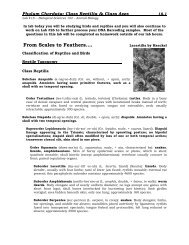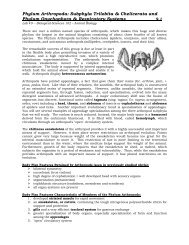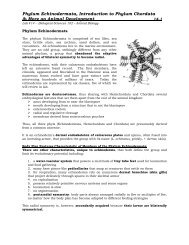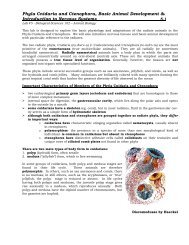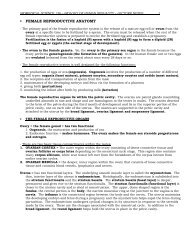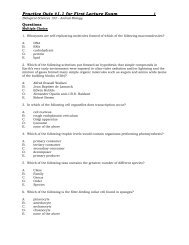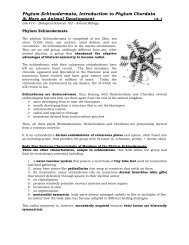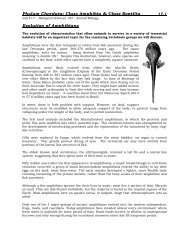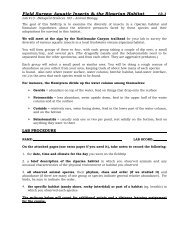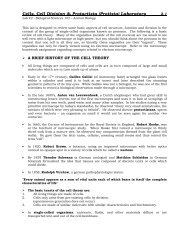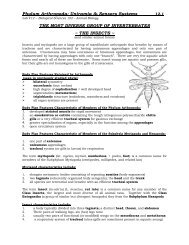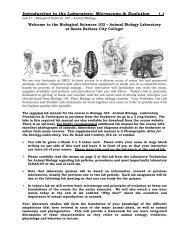Phyla Cnidaria and Ctenophora, Basic Animal Development ...
Phyla Cnidaria and Ctenophora, Basic Animal Development ...
Phyla Cnidaria and Ctenophora, Basic Animal Development ...
You also want an ePaper? Increase the reach of your titles
YUMPU automatically turns print PDFs into web optimized ePapers that Google loves.
<strong>Phyla</strong> <strong>Cnidaria</strong> <strong>and</strong> <strong>Ctenophora</strong>, <strong>Basic</strong> <strong>Animal</strong> <strong>Development</strong> &<br />
Introduction to Nervous Systems 5.12<br />
Lab #5 - Biological Sciences 102 – <strong>Animal</strong> Biology<br />
Discharge of nematocysts involves the following events:<br />
1. molecules released from prey may sensitize the cnidocytes, but tactile stimulation causes<br />
the nematocysts to discharge<br />
2. discharge is due to tensional forces created by a very high osmotic pressure within the<br />
nematocyst<br />
3. when triggered the high osmotic pressure causes water to rush in to the capsule.<br />
3. the build of water (increased hydrostatic pressure) forces the filament out <strong>and</strong> it turns<br />
inside out at the same time<br />
4. the barbs are then exposed <strong>and</strong>, if present, poison is injected into the prey<br />
Nematocysts of most cnidarians are not harmful to humans, but the stings of Physalia <strong>and</strong><br />
some true jellies are painful <strong>and</strong> can be dangerous – particularly if the individual is allergic to<br />
the organic poison.<br />
The instructor will remove the tip of a tentacle from Corynactis californica or similar species<br />
<strong>and</strong> prepare a slide by squashing the tip under a cover slip.<br />
Label the undischarged <strong>and</strong> sketch a discharged nematocyst below.<br />
UNDISCHARGED NEMATOCYST DISCHARGED NEMATOCYST<br />
Subclass Ceriantipatharia<br />
Order Ceriantharia (tube anemones)<br />
Observe the specimens <strong>and</strong>/or diagrams of the following species.<br />
Record the descriptive information requested at the end of the lab for these species.<br />
The available ceriantharian such as Pachycerianthus fimbriatus<br />
Subclass Octocorallia<br />
Under a dissecting scope, observe the polyp morphology of Lophogorgia chilensis or Renilla<br />
kollikeri to identify the unique features of an octocorallian polyp.<br />
Record the descriptive information requested at the end of the lab for these species.



